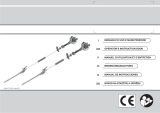
GB
17
properly used. The use of these devices can reduce dust-
related hazards.
h) Do not let the familiarity gained with the frequent use of
the tools allow you to become careless and ignore the
safety principles of the tools. An act of negligence can
cause serious injury in a fraction of a second.
i) If you wish to give or lend the machine to others, make sure
that the user sees the instructions for use contained in this
manual.
4) Power tool use and care
a) Do not overload the power tool. Use the correct power tool
for the job. The correct power tool will do the job better and
more safely at the rate for which it was designed.
b) Do not use the power tool if the switch does not turn it on
and off. A power tool that cannot be controlled with the
switch is dangerous and must be repaired.
c) Remove the rechargeable battery from its housing before
making any adjustments, changing accessories, or before
storing the power tool. These preventive safety measures
reduce the risk of accidentally starting up the power tool.
d) Store idle power tools out of the reach of children and do
not allow persons unfamiliar with the power tool or these
instructions to operate the power tool. Power tools are
dangerous in the hands of untrained users.
e) Take care of power tool maintenance. Check that moving
parts are aligned and can move freely, that no parts are
broken, and for any other condition that may affect the
operation of the power tool. If damaged, have the power
tool repaired before use. Many accidents are caused by poor
maintenance.
f) Keep cutting tools clean and sharp. Properly maintained
cutting tools with sharp cutting edges are less prone to
jamming and are easier to control.
g) Use the power tool and its accessories according to the
instructions given, considering the working conditions and
the type of work to be performed. Using the power tool for
operations different from those intended could result in
hazardous situations.
h) Keep handles and grip surfaces dry, clean, and free from
oil and grease. Slippery handles and grip surfaces do not
enable safe handling and control of the machine in
unforeseen situations.
5) Service
Have your power tool serviced by a qualified repair person
using only original spare parts. This will ensure the safety of the
power tool.
SAFETY WARNINGS FOR ELECTRIC HEDGETRIMMERS
WARNING! While using the machine, follow the safety
rules. Before starting the machine, read the instructions
for your own safety and that of others. Keep the
instructions in good conditions for later us
- Keep all parts of the body away from the cutter blade. Do
not remove cut material or hold material to be cut when
blades are moving. Make sure the switch lever is not
pressed when removing cut material. A moment of
distraction while operating the hedgetrimmers may result
in serious personal injury.
- Carry the hedgetrimmers by the handle with the cutter
blade stopped. Always install the cutting device guard
while transporting or when the machine is stored. Proper
handling of the hedgetrimmers reduces the possibility of
personal injury caused by the blades.
- Hold the power tool by the insulated gripping surfaces
only, as the blade may come into contact with hidden
cables. Cutter blades contacting a “live” cable can energize
the metal parts of the tool and could give the operator an
electric shock.
3. RULES FOR OPERATION
How to operate the battery-powered electric
hedgetrimmers
During operation, keep a firm and stable position, and maintain
a cautious attitude.
- Avoid working on wet or slippery ground, or on rough or
steep terrain that will not ensure the operator’s stability
during operation.
- Never run, but walk and pay attention to the unevenness
of the ground and the presence of any obstacles.
- Assess the potential risks that may arise in the area to be
worked on, and take all the necessary precautions to
ensure your safety, particularly on slopes, uneven or
slippery terrain, or loose soil.
- On slopes, work across the slope, never downwards or
upwards.
- Pay close attention to cliffs, ditches or embankments.
- When using the machine near the road, pay attention to
traffic.
- Pay attention when near live electrical cables.
The machine must not be used by persons who are unable to
hold it firmly with both hands and/or remain steadily balanced
on their legs while working.
Never allow the machine to be used by children, or persons
unfamiliar with these instructions. Local laws may set a
minimum age for the operator.
The machine must not be used by more than one person.
Never use the machine:
- when people, especially children, or animals are nearby;
- if the user is tired or unwell, or has taken medications,
drugs, alcohol or substances harmful to their ability to
react and their alertness;
- if the guards are damaged or have been damaged or have
been removed.
Techniques for using the battery-powered electric
hedgetrimmers
Always follow the safety instructions and use cutting
techniques suitable for the type of work to be performed,
according to the instructions and examples given in the
instructions for use.
Safely handling the battery-powered electric
hedgetrimmers
Every time it is necessary to move or transport the machine, it
is necessary to:
- switch off the motor, wait for the cutting tool to stop and
remove the battery from its housing;
- hold the machine only by the handles and orient the
cutting device in the direction opposite the direction of
travel.













